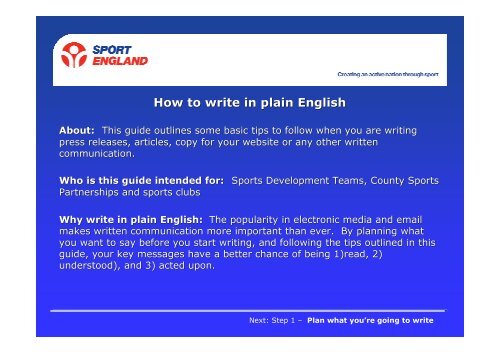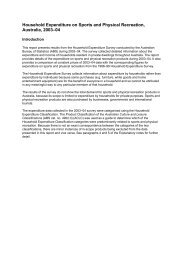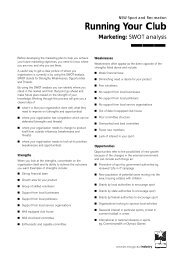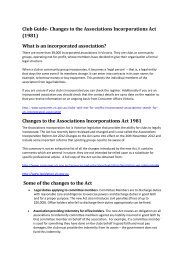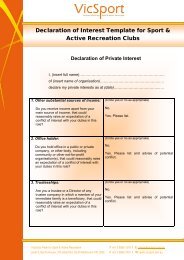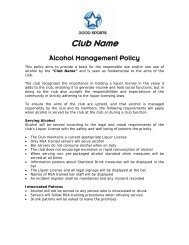Sport England Guide - How to write in plain English - VicSport
Sport England Guide - How to write in plain English - VicSport
Sport England Guide - How to write in plain English - VicSport
You also want an ePaper? Increase the reach of your titles
YUMPU automatically turns print PDFs into web optimized ePapers that Google loves.
<strong>How</strong> <strong>to</strong> <strong>write</strong> <strong>in</strong> pla<strong>in</strong> <strong>English</strong>About:This guide outl<strong>in</strong>es some basic tips <strong>to</strong> follow when you are writ<strong>in</strong>gpress releases, articles, copy for your website or any other writtencommunication.Who is this guide <strong>in</strong>tended for:Partnerships and sports clubs<strong>Sport</strong>s Development Teams, County <strong>Sport</strong>sWhy <strong>write</strong> <strong>in</strong> pla<strong>in</strong> <strong>English</strong>: The popularity <strong>in</strong> electronic media and emailmakes written communication more important than ever. By plann<strong>in</strong>g ng whatyou want <strong>to</strong> say before you start writ<strong>in</strong>g, and follow<strong>in</strong>g the tips outl<strong>in</strong>ed <strong>in</strong> thisguide, your key messages have a better chance of be<strong>in</strong>g 1)read, 2) 2unders<strong>to</strong>od), and 3) acted upon.Next: Step 1 – Plan what you’re go<strong>in</strong>g <strong>to</strong> <strong>write</strong>
1. Plan what you’re go<strong>in</strong>g <strong>to</strong> <strong>write</strong>Rather than start typ<strong>in</strong>g straight away, use a blank sheet of paper <strong>to</strong>capture key ideas which can then be worked up <strong>in</strong><strong>to</strong> sentences.What are you try<strong>in</strong>g <strong>to</strong> say? Write your first sentence at the very <strong>to</strong>pof the page and never lose sight of that. This is the sentence that has <strong>to</strong>capture your audience.Who are you writ<strong>in</strong>g <strong>to</strong>? Be careful with jargonistic language, keep th<strong>in</strong>gssimple, clear and concise.<strong>How</strong> much space or time have you got <strong>to</strong> make your po<strong>in</strong>t? Research saysthat people make a decision about whether or not they want <strong>to</strong> f<strong>in</strong>ishread<strong>in</strong>g an article or watch<strong>in</strong>g a news bullet<strong>in</strong> <strong>in</strong> the first eight seconds, sothey are critical <strong>to</strong> encourag<strong>in</strong>g people <strong>to</strong> cont<strong>in</strong>ue.Next: Step 2 – Outl<strong>in</strong>e key messages
2. Outl<strong>in</strong>e key messagesWrite four or five bullet po<strong>in</strong>ts about the key th<strong>in</strong>gs you want <strong>to</strong> get across <strong>in</strong>the piece of writ<strong>in</strong>g. If there were four messages you wanted your reader <strong>to</strong>walk away with what would they be?Next: Step 3 – Start writ<strong>in</strong>g
3. Start writ<strong>in</strong>gNow it is time <strong>to</strong> add meat <strong>to</strong> the bones of your article. If you are struggl<strong>in</strong>g <strong>to</strong><strong>write</strong> an <strong>in</strong>troduction, then leave it and come back <strong>to</strong> that bit at the end. Youoften come up with a better <strong>in</strong>tro when you have written the whole article.When writ<strong>in</strong>g, keep referr<strong>in</strong>g <strong>to</strong> your key po<strong>in</strong>ts, be ruthless!Do not <strong>write</strong> the headl<strong>in</strong>e until the article is f<strong>in</strong>ished. Do not try <strong>to</strong> be cleverwith headl<strong>in</strong>es, that is the job of journalists. Th<strong>in</strong>k of a l<strong>in</strong>e that sums up thearticle. A headl<strong>in</strong>e should be no more than eight words.Next: Writ<strong>in</strong>g tips
Writ<strong>in</strong>g tipsKeep your sentences short. This is the most important tip. Make simple, baldstatements.Make sure your short sentences follow on from one another and that they donot jump about from issue <strong>to</strong> issue.It is now acceptable <strong>to</strong> start sentences with conjunctives (but, and, however)Pla<strong>in</strong> language is key.It is okay <strong>to</strong> use bullet po<strong>in</strong>ts <strong>in</strong> articles, <strong>to</strong> take away from us<strong>in</strong>g the word“and” <strong>to</strong>o much.Next: More writ<strong>in</strong>g tips
Writ<strong>in</strong>g tipsIf you are struggl<strong>in</strong>g <strong>to</strong> th<strong>in</strong>k of another word <strong>to</strong> use <strong>in</strong>stead of the obviousone, don’t forget that Microsoft Word has a built <strong>in</strong> thesaurus. Or you could<strong>write</strong> the word at the <strong>to</strong>p of a page and <strong>write</strong> a list of similar words underneathit. Don’t be afraid <strong>to</strong> ask colleagues for examples of better words.Go with your <strong>in</strong>st<strong>in</strong>ct. If <strong>in</strong> doubt leave it out.Sometimes it’s helpful <strong>to</strong> work with someone when putt<strong>in</strong>g articles <strong>to</strong>gether,either gett<strong>in</strong>g them <strong>to</strong> check your work or <strong>to</strong> spend 10 m<strong>in</strong>utes <strong>to</strong>getherwork<strong>in</strong>g on it. Two heads are better than one.If you cannot fit all your key messages <strong>in</strong> the article, you can use them <strong>in</strong>quotes.Next: More writ<strong>in</strong>g tips
Writ<strong>in</strong>g tipsIf you cannot fit all your key messages <strong>in</strong> the article, you can use them <strong>in</strong>quotes.Quotes should be plausible and sound like someth<strong>in</strong>g the person would actuallySay.Quotes should be well l<strong>in</strong>ked and relevant <strong>to</strong> the sentence directly above it.For an article it is not very imag<strong>in</strong>ative if all quotes sit at the bot<strong>to</strong>m of thepage. If you try <strong>to</strong> work quotes <strong>in</strong><strong>to</strong> the copy then journalists will f<strong>in</strong>d it harder<strong>to</strong> remove the quotes.Next: More writ<strong>in</strong>g tips
Writ<strong>in</strong>g tipsRather than just hav<strong>in</strong>g one key message on its own, try <strong>to</strong> work them <strong>in</strong><strong>to</strong> themiddle of a sentence.For feature articles for magaz<strong>in</strong>es etc, try <strong>to</strong> give the article a theme andalways end the article with repetition of the beg<strong>in</strong>n<strong>in</strong>g of the article and a f<strong>in</strong>althought, someth<strong>in</strong>g for the reader <strong>to</strong> take away with them.Next: Check List
Check List1234What are tryng <strong>to</strong> say?Who are you writ<strong>in</strong>g <strong>to</strong>?What are your key messages?What is your headl<strong>in</strong>e?


